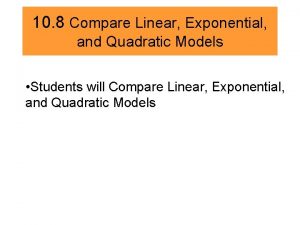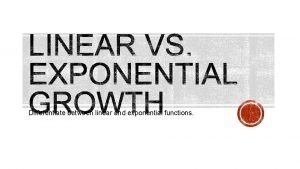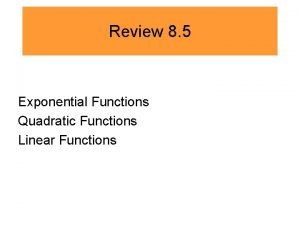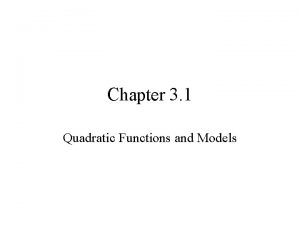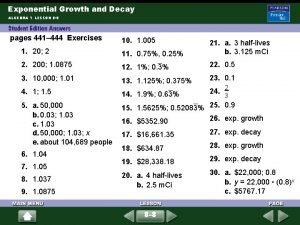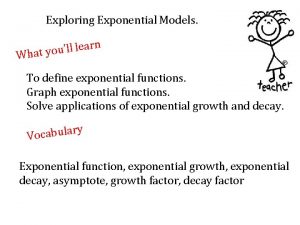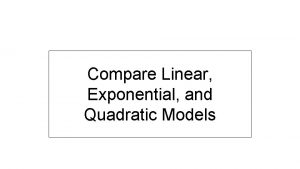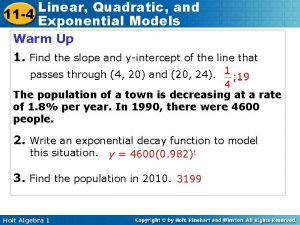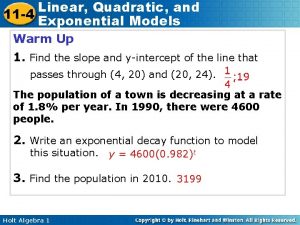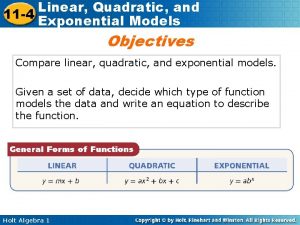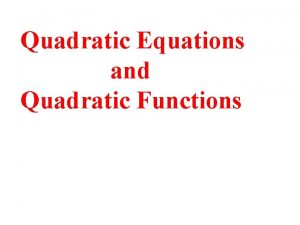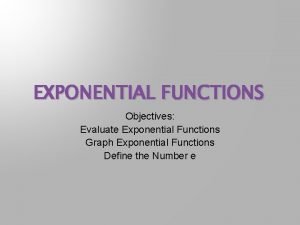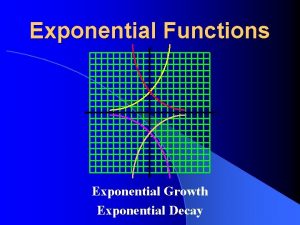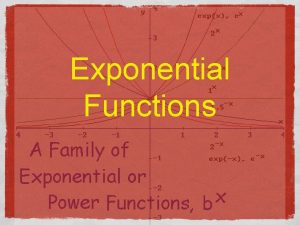10 8 Compare Linear Exponential and Quadratic Models













- Slides: 13

10. 8 Compare Linear, Exponential, and Quadratic Models • Students will Compare Linear, Exponential, and Quadratic Models

Identifying from an equation: Linear Quadratic Exponential Has an x with no exponent. Has an x 2 in the equation. Has an x as the exponent. y = 5 x + 1 y = ½x 2 x + 3 y = 6 y = 2 x 2 + 3 x – 5 y = x 2 + 9 x 2 + 4 y = 7 y = 3 x + 1 y = 52 x 4 x + y = 13

Examples: • LINEAR, QUADRATIC or EXPONENTIAL? a)y = 6 x + 3 b)y = 7 x 2 +5 x – 2 c)9 x + 3 = y d)42 x = 8

Identifying from a graph: Linear Quadratic Exponential Makes a straight line Makes a U or ∩ Rises or falls quickly in one direction

LINEAR, QUADRATIC or EXPONENTIAL? a) b) c) d)

Is the table linear, quadratic or exponential? Linear • Never see the same y value twice. • 1 st difference is the same Quadratic • See same y more than once. • 2 nd difference is the same Exponential • y changes more quickly than x. • Never see the same y value twice. • Common multiplication pattern

EXAMPLE 2 b. Identify functions using differences or ratios x – 2 – 1 0 1 2 y – 2 1 4 7 10 Differences: 3 3 ANSWER The table of values represents a linear function.

EXAMPLE 2 Identify functions using differences or ratios Use differences or ratios to tell whether the table of values represents a linear function, an exponential function, or a quadratic function. a. x y – 2 – 6 First differences: 0 Second differences: 2 – 1 – 6 0 – 4 2 1 0 4 2 2 6 6 2 ANSWER The table of values represents a quadratic function .

GUIDED PRACTICE for Examples 1 and 2 2. Tell whether the table of values represents a linear function, an exponential function, or a quadratic function. ANSWER x – 2 – 1 0 1 y 0. 08 0. 4 2 10 exponential function

x y 0 -5 -2 -2 1 -4 -1 -4 2 -1 0 -8 3 4 2 -32 4 11 5 -256

Is the table linear, quadratic or exponential? x y x y 1 5 1 0 1 3 2 9 2 -1 2 9 3 13 3 0 3 27 4 17 4 3 4 81 5 21 5 8 5 243

EXAMPLE 3 Write an equation for a function Tell whether the table of values represents a linear function, an exponential function, or a quadratic function. Then write an equation for the function. x – 2 – 1 0 1 2 y 2 0. 5 0 0. 5 2

EXAMPLE 3 Write an equation for a function SOLUTION STEP 1 Determine which type of function the table of values represents. x – 2 – 1 0 1 2 y 2 0. 5 0 0. 5 2 First differences: – 1. 5 Second differences: 1 – 0. 5 1 1. 5 1
 Linear, quadratic exponential examples
Linear, quadratic exponential examples Linear vs quadratic vs exponential
Linear vs quadratic vs exponential Difference between exponential and linear
Difference between exponential and linear Write linear and exponential functions from tables
Write linear and exponential functions from tables What's the difference between heliocentric and geocentric
What's the difference between heliocentric and geocentric Exponential and logarithmic models
Exponential and logarithmic models What is modals and semi modals
What is modals and semi modals Domain of parabola
Domain of parabola Linear and quadratic functions and modeling
Linear and quadratic functions and modeling Lesson 13-1 exponential growth functions answers
Lesson 13-1 exponential growth functions answers Exponential decay models
Exponential decay models 7-1 practice exploring exponential models form g
7-1 practice exploring exponential models form g 7-1 exploring exponential models
7-1 exploring exponential models Exponential growth vs decay
Exponential growth vs decay
